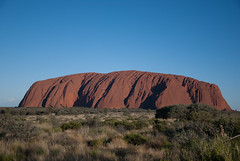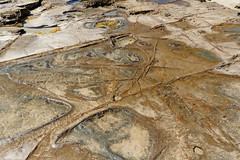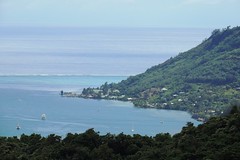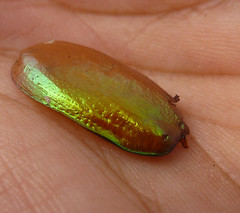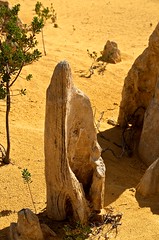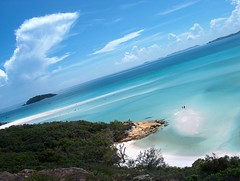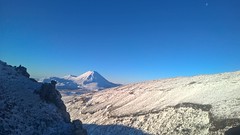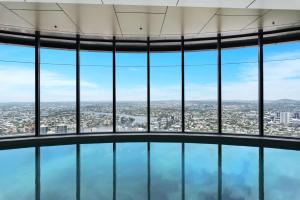Oceania
Oceania (English: /ˌsiˈniəˌʃi--ˈn-/, English: /ˌʃiˈæniə/, English: /-ˈn-/) is a geographical region that is described as a continent in some parts of the world. It includes Australasia, Melanesia, Micronesia, and Polynesia. Spanning the Eastern and Western Hemispheres, Oceania is estimated to have a land area of and a population of around 44.4 million as of 2022. Oceania is described as a geographical region in most of the English-speaking world, but outside of the English-speaking world, Oceania is described as one of the continents. In this model of the world, Australia is only seen as an island nation contained inside of the continent of Oceania, and not a continent by itself. When compared to the other continents, Oceania is the smallest in land area and the second least populated after Antarctica.
Oceania has a diverse mix of economies from the highly developed and globally competitive financial markets of Australia, French Polynesia, Hawaii, New Caledonia, and New Zealand, which rank high in quality of life and Human Development Index, to the much less developed economies of Kiribati, Papua New Guinea, Tuvalu, Vanuatu, and Western New Guinea, while also including medium-sized economies of Pacific islands such as Fiji, Palau, and Tonga. The largest and most populous country in Oceania is Australia, and the largest city is Sydney. Puncak Jaya in Highland Papua, Indonesia, is the highest peak in Oceania at .
The first settlers of Australia, New Guinea, and the large islands just to the east arrived more than 60,000 years ago. Oceania was first explored by Europeans from the 16th century onward. Portuguese explorers, between 1512 and 1526, reached the Tanimbar Islands, some of the Caroline Islands and west New Guinea. Spanish and Dutch explorers followed, then British and French. On his first voyage in the 18th century, James Cook, who later arrived at the highly developed Hawaiian Islands, went to Tahiti and followed the east coast of Australia for the first time.
The arrival of European settlers in subsequent centuries resulted in a significant alteration in the social and political landscape of Oceania. The Pacific theatre saw major action during the Second World War, mainly between Allied powers the United States, Philippines (a U.S. Commonwealth at the time) and Australia, and Axis power Japan. The rock art of Aboriginal Australians is the longest continuously practiced artistic tradition in the world. Most Oceanian countries are multi-party representative parliamentary democracies, with tourism being a large source of income for the Pacific Islands nations.
Definitions and extent
Characteristics
Definitions of Oceania vary. The broadest definition of Oceania encompasses the many islands between mainland Asia and the Americas; The island nation of Australia is the only piece of land in the area which is large enough to typically be considered a continent. The culture of the people who lived on these islands was often distinct from that of Asia and pre-Columbian America, hence a lack of association with either. Before Europeans arrived in the area, the sea shielded Australia and south central Pacific islands from cultural influences that spread through large continental landmasses and adjacent islands. The islands of the Malay archipelago, north of Australia, mainly lie on the continental shelf of Asia, and their inhabitants had more exposure to mainland Asian culture as a result of this closer proximity. The island of Taiwan similarly lies on the continental shelf of Asia, with their inhabitants historically having had exchange with mainland Asia.
The geographer Conrad Malte-Brun coined the French expression Terres océaniques (Oceanic lands) 1804, then in 1814 another French cartographer, Adrien-Hubert Brué, coined from this expression the shorter "Océanie" putting it on a map, "Océanie, ou cinquième partie du monde, comprenant l'archipel d'Asie, l'Australasie et la Polynésie (ou le continent de la Nouvelle Hollande et les îles du Grand Océan)". Océanie derives from the Latin word , and this from the Greek word (ōkeanós), "ocean". The term Oceania is used because, unlike the other continental groupings, it is the ocean that links the parts of the region together. John Eperjesi's 2005 book The Imperialist Imaginary: Visions of Asia and the Pacific in American Culture says that it has "been used by western cartographers since the mid-19th century to give order to the complexities of the Pacific area." The Handbook of Religion (2014) states that it was "introduced by westerners" and in the 19th century helped describe "a sociopolitical reality of the islands of the southwest Pacific and Australia."
In the 19th century, many geographers divided up Oceania into mostly racially based subdivisions; Australasia, Malesia (encompassing the Malay archipelago), Melanesia, Micronesia and Polynesia. The 2011 book Maritime Adaptations of the Pacific, by Richard W. Casteel and Jean-Claude Passeron, states that, "for the purpose of anthropology, Oceania has long been a continent like Africa, Asia and America." Scottish geographer John Bartholomew wrote in 1873 that, "the New World consists of North America, and the peninsula of South America attached to it. These divisions are generally themselves spoken as continents, and to them has been added another, embracing the large island of Australia and numerous others in the pacific Ocean, under the name of Oceania. There are thus six great divisions of the earth — Europe, Asia, Africa, North America, South America and Oceania." American author Samuel Griswold Goodrich wrote in his 1854 book History of All Nations that, "geographers have agreed to consider the island world of the Pacific Ocean as a third continent, under the name Oceania." In this book the other two continents were categorized as being the New World (consisting of the Americas) and the Old World (consisting of Afro-Eurasia). One study from 1884 describes Oceania as a continent, stating that "South of the continent of Asia is found a large island nearly as large as the continent of Europe. This, with a great number of small islands in the neighbourhood, is regarded as forming a fourth continent known as Oceania." Other studies from the early twentieth Century also described Oceania as a continent. In his 1879 book Australasia, British naturalist Alfred Russel Wallace commented that, "Oceania is the word often used by continental geographers to describe the great world of islands we are now entering upon" and that "Australia forms its central and most important feature." He did not explicitly label Oceania a continent in the book, but did note that it was one of the six major divisions of the world. The Oxford Handbook of World History (2011) describes the areas encompassed in Oceania as being "afterthoughts in world history texts, lumped together and included at the end of global surveys as areas largely marginal to the main events of world history".
In most non-English speaking countries Oceania is treated as a continent in the sense that it is "one of the parts of the world", and Australia is only seen as an island nation. While in other non-English speaking countries Australia and Eurasia are thought of as continents, while Asia, Europe, and Oceania are regarded as "parts of the world". Prior to the 1950s, before the popularization of the theory of plate tectonics, Antarctica, Australia and Greenland were sometimes described as island continents, but none were usually taught as one of the world's continents in English-speaking countries. In her 1961 book The United States and the Southwest Pacific, American author Clinton Hartley Grattan commented that, "the use of the word Oceania to cover Australia, New Zealand, and the pacific islands now has a slightly old-fashioned flavor." Australia is a founding member of the Pacific Islands Forum in 1971, and at times has been interpreted as the largest Pacific island. For example, Tony deBrum, Foreign Minister for the Marshall Islands, stated in 2014, "not only Australia our big brother down south, Australia is a member of the Pacific Islands Forum and Australia is a Pacific island, a big island, but a Pacific island." Some geographers group the Australian tectonic plate with others in the Pacific to form a geological continent. National Geographic states that the term Oceania "establishes the Pacific Ocean as the defining characteristic of the continent." Others have labelled it as the "liquid continent". The Pacific Ocean itself has been labelled as a "continent of islands", and contains approximately 25,000, which is more than all the other major oceans combined. In a 1991 article for the Submerged Resources Center, American archeologist Toni L. Carrell wrote, "the immensity of and great distances within the Pacific Basin often make it difficult to conceptualize the basin as a single earth feature." She adds that most islands in the Pacific are "close enough together to be easily clustered into archipelagos or groups. The notable exceptions, those islands more than 400 statute miles from any other, are: Clipperton Island, Easter Island, Salas y Gómez, Johnston Atoll, Norfolk Island, Marcus Island and Parece Vela." In his 2013 book Reptiles and Amphibians of the Pacific Islands: A Comprehensive Guide, American herpetologist wrote, "what is and is not part of the Pacific—particularly the western Pacific—is variously delimited", adding that "a majority viewpoint accepts the landmasses of Japan, Taiwan, the Philippines, New Guinea, and eastern Australia, which face the open waters of the Pacific, as its western edge." Islands in Indonesia's North Maluku and North Sulawesi regions are considered to border the open Pacific Ocean, with the rest of the Indonesian islands being located in marginal seas of the Pacific, or the Indian Ocean. Oceania's subregions of Australasia, Melanesia, Micronesia, and Polynesia cover two major plates; the Australian Plate (also known as the…
Hotels Oceania
Looking for places related to Oceania?
Those are other destinations to find places related to Oceania:



